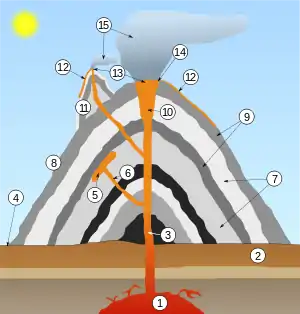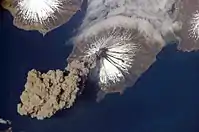Volcanoes periodically erupt with volcanic gases, lava, and ash. There is a scale used in judging a volcanic eruption's size, called the Volcanic Explosivity Index, or VEI, scale. A table with some information included is right below.
Classification
Scientists measure how powerful volcanic eruptions are using the VEI. It records how much volcanic material is thrown out, how high the eruption goes, and how long it lasts. The scale goes from 0 to 8. A score of 1 is 10 times more powerful than a score of 0; this is a logarithmic scale, like decibels or the Richter scale.
| VEI | Classification | Description | Plume | Ejecta volume | Frequency | Example | Occurrences * |
|---|---|---|---|---|---|---|---|
| 0 | Hawaiian Eruption | non-explosive | < 100 m | < 10,000 m³ | daily | Mauna Loa | many |
| 1 | Strombolian | gentle | 100-1000 m | > 10,000 m³ | daily | Stromboli | many |
| 2 | Strombolian/Vulcanian | explosive | 1-5 km | > 1,000,000 m³ | weekly | Galeras (1993) | 3477* |
| 3 | Vulcanian/Pelean | severe | 3-15 km | > 10,000,000 m³ | yearly | Nevado del Ruiz (1985) | 868 |
| 4 | Peléan eruption/Plinian | cataclysmic | 10-25 km | > 0.1 km³ | ≥ 10 yrs | Soufrière Hills (1995) | 278 |
| 5 | Plinian | paroxysmal | > 25 km | > 1 km³ | ≥ 50 yrs | Mount St. Helens (1980) | 84 |
| 6 | Plinian/Ultra-Plinian | colossal | > 25 km | > 10 km³ | ≥ 100 yrs | Mount Pinatubo (1991) | 39 |
| 7 | Plinian/Ultra-Plinian | super-colossal | > 25 km | > 100 km³ | ≥ 1000 yrs | Mount Tambora (1815) | 5 (+2 suspected) |
| 8 | Ultra-Plinian | mega-colossal | > 25 km | > 1,000 km³ | ≥ 10,000 yrs | Lake Toba (73,000 Before present) | 1 |
| 9 | Ultra-Ultra-Plinian | fortunately | > 25 km | > 10,000 km³ | ≥ 10,000,000 | Possibly the Siberian Traps | 0 |
* Count of eruptions in the last 10,000 years based on 1994 figures maintained by the Global Volcanism Program of the Smithsonian Institution
Note that there is a discontinuity in the definition of the VEI between indices 1 and 2. The lower border of the volume of ejecta jumps by a factor of 100 from 10,000 to 1,000,000 m³ while the factor is 10 between all higher indices.
Introduction

| Cross-section through a stratovolcano: | |
|---|---|
| 1. Large magma chamber 2. Bedrock 3. Conduit (pipe) 4. Base 5. Sill 6. Branch pipe 7. Layers of ash emitted by the volcano 8. Flank |
9. Layers of lava emitted by the volcano 10. Throat 11. Parasitic cone 12. Lava flow 13. Vent 14. Crater 15. Ash cloud |

A volcano is an opening, or rupture, in a planet's surface or crust, which allows hot, molten rock, ash, and gases to escape from below the surface. Volcanic activity involving the extrusion of rock tends to form mountains or features like mountains over a period of time.
Volcanoes are generally found where tectonic plates are pulled apart or come together. A mid-oceanic ridge, for example the Mid-Atlantic Ridge and mid-oceanic ridge, has examples of volcanoes caused by "divergent tectonic plates" pulling apart; the Pacific Ring of Fire has examples of volcanoes caused by "convergent tectonic plates" coming together. By contrast, volcanoes are usually not created where two tectonic plates slide past one another. Volcanoes can also form where there is stretching and thinning of the Earth's crust (called "non-hotspot intraplate volcanism"), such as in the African Rift Valley, the Wells Gray-Clearwater Volcanic Field and the Rio Grande Rift in North America and the European Rhine Graben with its Eifel volcanoes.
Volcanoes can be caused by "mantle plumes". These so-called "hotspots" , for example at Hawaii, can occur far from plate boundaries. Hotspot volcanoes are also found elsewhere in the solar system, especially on rocky planets and moons.